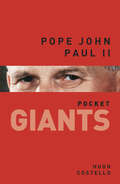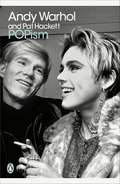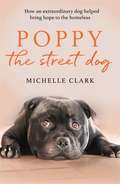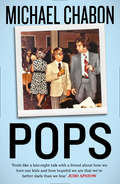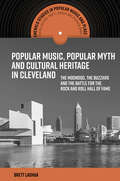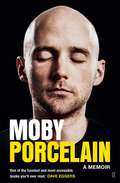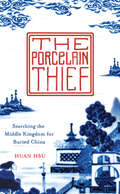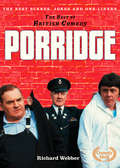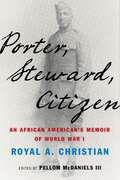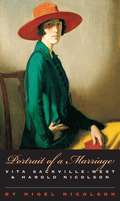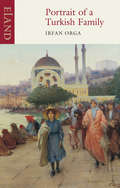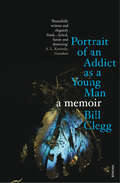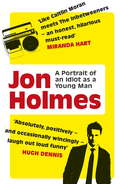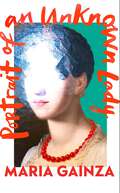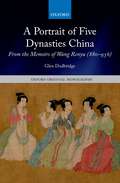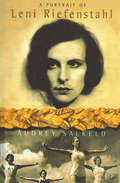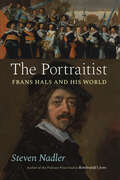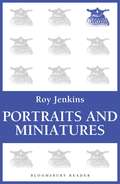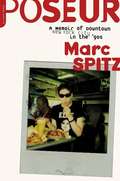- Table View
- List View
Pope John Paul II: pocket GIANTS (Pocket Giants Ser.)
by Hugh CostelloThe world was stunned when little-known Karol Wojtyla became the first non-Italian pope for 450 years. As Pope John Paul II, he continued to surprise, directly confronting Communist regimes, flying hundreds of thousands of miles to meet the faithful, and building bridges with other faiths. John Paul II became a bête noire in the eyes of liberals for his staunch refusal to accept contraception or the ordination of women. But for others he was a Churchillian figure who took on the forces of godlessness and moral relativism. He gained a stature that left secular statesmen in his shadow. Love him or loathe him, few could deny that he was a man of rare courage. He survived two assassination attempts, fought off cancer and waged a very public battle with Parkinson’s disease. Seven years after his death he continues to exert a hold over the Church and to inspire an almost cult-like devotion.
POPism: The Warhol Sixties (Penguin Modern Classics)
by Andy Warhol Pat HackettA cultural storm swept through the 1960s -- Pop Art, Bob Dylan, psychedelia, underground movies -- and at its centre sat a bemused young artist with silver hair: Andy Warhol. Andy knew everybody (from the cultural commissioner of New York to drug-driven drag queens) and everybody knew Andy. His studio, the Factory, was the place: where he created the large canvases of soup cans and Pop icons that defined Pop Art, where one could listen to the Velvet Underground and rub elbows with Edie Sedgwick and where Warhol himself could observe the comings and goings of the avant-guarde.
Poppy The Street Dog: How an extraordinary dog helped bring hope to the homeless
by Michelle ClarkA heartwarming true animal story, for fans of A Dog's Purpose, A Street Cat Named Bob and Marley & Me. Michelle Clark has loved animals all her life, filling her home with a menagerie of stray cats and abandoned dogs. But when her outreach work with London's homeless community leads to a chance meeting with a desperate man, and a quest to find a missing Staffie named Poppy, she has no idea that her life will be transformed forever.Poppy is unlike any other dog that Michelle has ever met, with her unwavering loyalty, gentle nature and wise, kind eyes. Soon, Poppy finds her way not just into Michelle's heart, but into her home too.Inspired Poppy's extraordinary love and devotion, Michelle finds herself at the start of a journey to bring hope and help to the hundreds of other precious dogs who call the city streets their home.An inspiring, heartwarming true story about the incredible bond that exists between humans and animals, and how, in rescuing them, we can also rescue ourselves.
Pops: Fatherhood In Pieces
by Michael ChabonMichael Chabon, author of The Amazing Adventures of Kavalier and Clay, Manhood for Amateurs and Moonglow, returns with a collection of heartfelt, humorous and insightful essays on the meaning of fatherhood.
Popular Music, Popular Myth and Cultural Heritage in Cleveland: The Moondog, the Buzzard and the Battle for the Rock and Roll Hall of Fame (Emerald Studies in Popular Music and Place)
by Brett LashuaDrawing from research conducted at the Rock and Roll Hall of Fame archives, and the author's experience as a local musician, this book offers a micro-historical case study of Cleveland's popular music heritage. Among just a handful of books dedicated to the popular music heritage of Cleveland, it traces myths of "where rock began to roll" in the self-proclaimed "birthplace of rock and roll". Numerous cities have sought to capitalize on their popular music cultural heritage (e.g., Liverpool, Memphis, Detroit, Nashville) as an engine for cultural regeneration. Unusually, rather than a focus on famous musicians and groups, or well-known recording studios and legendary venues, Cleveland's popular music "origin story" is spun from events of the early 1950s, centered on local radio stations, maverick disc jockeys, second-hand record stores, a riotous concert and youthful, racialized audiences at a moment on the cusp of sweeping social changes. This book untangles the construction of popular myths about "first" rock 'n' roll concert--the Moondog Coronation Ball on 21 March 1952, hosted by legendary DJ Alan Freed--the "invention" of the phrase "rock 'n' roll", and the subsequent rebranding of Cleveland as the "birthplace of rock 'n' roll" by local radio station WMMS "The Buzzard" during the 1970s. These myths re-emerged and re-circulated in the 1980s during the successful campaign to attract the Rock and Roll Hall of Fame. The author explores the fascinating and unusual story of Cleveland, uncovering how and why it became the site of a major popular music museum.
Popular Music, Popular Myth and Cultural Heritage in Cleveland: The Moondog, the Buzzard and the Battle for the Rock and Roll Hall of Fame (Emerald Studies in Popular Music and Place)
by Brett LashuaDrawing from research conducted at the Rock and Roll Hall of Fame archives, and the author's experience as a local musician, this book offers a micro-historical case study of Cleveland's popular music heritage. Among just a handful of books dedicated to the popular music heritage of Cleveland, it traces myths of "where rock began to roll" in the self-proclaimed "birthplace of rock and roll". Numerous cities have sought to capitalize on their popular music cultural heritage (e.g., Liverpool, Memphis, Detroit, Nashville) as an engine for cultural regeneration. Unusually, rather than a focus on famous musicians and groups, or well-known recording studios and legendary venues, Cleveland's popular music "origin story" is spun from events of the early 1950s, centered on local radio stations, maverick disc jockeys, second-hand record stores, a riotous concert and youthful, racialized audiences at a moment on the cusp of sweeping social changes. This book untangles the construction of popular myths about "first" rock 'n' roll concert--the Moondog Coronation Ball on 21 March 1952, hosted by legendary DJ Alan Freed--the "invention" of the phrase "rock 'n' roll", and the subsequent rebranding of Cleveland as the "birthplace of rock 'n' roll" by local radio station WMMS "The Buzzard" during the 1970s. These myths re-emerged and re-circulated in the 1980s during the successful campaign to attract the Rock and Roll Hall of Fame. The author explores the fascinating and unusual story of Cleveland, uncovering how and why it became the site of a major popular music museum.
Porcelain: A Memoir
by MobyThere were many reasons Moby was never going to make it as a DJ and musician in the New York club scene of the late 1980s and early 90s. This was the New York of Palladium, of Mars, Limelight, and Twilo, an era when dance music was still a largely underground phenomenon, popular chiefly among working-class African Americans and Latinos. And then there was Moby-not just a poor, skinny white kid from deepest Connecticut, but a devout Christian, a vegan, and a teetotaler, in a scene that was known for its unchecked drug-fueled hedonism. He would learn what it was to be spat on, literally and figuratively. And to live on almost nothing. But it was perhaps the last good time for an artist to live on nothing in New York City ... And so by the end of the decade, Moby contemplated the end of things, in his career and elsewhere in his life, and he put that emotion into what he assumed would be his swan song, his good-bye to all that, the album that would be in fact the beginning of an astonishing new phase in his life, the multimillion-selling Play. Porcelain is about making it, losing it, loving it, and hating it. It's about finding your people, and your place, thinking you've lost them both, and then, finally, somehow, creating a masterpiece. As a portrait of the young artist, Porcelain is a masterpiece in its own right, fit for the short shelf of musicians' memoirs that capture not just a scene but an age and something timeless about the human condition. Push play.
The Porcelain Thief: Searching The Middle Kingdom For Buried China
by Huan HsuIn 1938, with the Japanese army approaching from Nanking, Huan Hsu’s great-great grandfather, Liu, and his five granddaughters, were forced to flee their hometown on the banks of the Yangtze River. But before they left a hole was dug as deep as a man, and as wide as a bedroom, in which was stowed the family heirlooms.
Porridge: The Inside Story (The Best of British Comedy)
by Richard WebberThe best jokes, gags and scenes from a true British comedy classic. ‘Cheer up, could be worse. State the country's in, we could be free.’
Porter, Steward, Citizen: An African American's Memoir of World War I
by Royal A. ChristianIn 1917, the year the United States entered the Great War, Colonel Moorhead C. Kennedy, one of the most powerful men in the state of Pennsylvania and now the Deputy Director General of Transportation for the American Expeditionary Force, asked his African American valet if he would like to accompany him on an overseas mission. The valet's reaction was "Yes, sir." And he, as he recounted years later, "at once had visions of France." So began Royal Christian's odyssey in Europe. After a tumultuous crossing of the Atlantic as a third class steward on board a British steamship, he survived London's aerial bombing and then celebrated the end of the war in that city's streets. At last, he reached the long anticipated Paris, where he could admire the Eiffel Tower and the astonishing windows of Notre Dame. Royal Christian chronicled his extraordinary experiences in a memoir, Roy's Trip to the Battlefields of Europe, that was privately published in 1919. Rich in historical details, cultural observations, and political reflections, this book is a vital testimony to the history of African American men participating in World War I. After almost a century, Pellom McDaniels III has unearthed this gem, providing an elegantly annotated edition of Christian's memoir. Porter, Steward, Citizen nods both directly and indirectly to the challenges that African Americans encountered in their efforts to serve the cause of freedom and democracy, even as they were denied access to those rights by Jim Crow laws at home. Christian's unique story vividly illustrates how the war helped African American men claim a sense of manhood tied to their military service, and their efforts to transform themselves and their families into full-fledged American citizens. While race often served as a barrier in the army, this book suggests that some black men managed to take advantage of their outsider-within status and thrive: elevating not only themselves but also their community within a society that maintained a deep and abiding attachment to the myth of white supremacy.
Porter, Steward, Citizen: An African American's Memoir of World War I
by Royal A. ChristianIn 1917, the year the United States entered the Great War, Colonel Moorhead C. Kennedy, one of the most powerful men in the state of Pennsylvania and now the Deputy Director General of Transportation for the American Expeditionary Force, asked his African American valet if he would like to accompany him on an overseas mission. The valet's reaction was "Yes, sir." And he, as he recounted years later, "at once had visions of France." So began Royal Christian's odyssey in Europe. After a tumultuous crossing of the Atlantic as a third class steward on board a British steamship, he survived London's aerial bombing and then celebrated the end of the war in that city's streets. At last, he reached the long anticipated Paris, where he could admire the Eiffel Tower and the astonishing windows of Notre Dame. Royal Christian chronicled his extraordinary experiences in a memoir, Roy's Trip to the Battlefields of Europe, that was privately published in 1919. Rich in historical details, cultural observations, and political reflections, this book is a vital testimony to the history of African American men participating in World War I. After almost a century, Pellom McDaniels III has unearthed this gem, providing an elegantly annotated edition of Christian's memoir. Porter, Steward, Citizen nods both directly and indirectly to the challenges that African Americans encountered in their efforts to serve the cause of freedom and democracy, even as they were denied access to those rights by Jim Crow laws at home. Christian's unique story vividly illustrates how the war helped African American men claim a sense of manhood tied to their military service, and their efforts to transform themselves and their families into full-fledged American citizens. While race often served as a barrier in the army, this book suggests that some black men managed to take advantage of their outsider-within status and thrive: elevating not only themselves but also their community within a society that maintained a deep and abiding attachment to the myth of white supremacy.
Portrait of a Marriage: Vita Sackville-West and Harold Nicolson
by Nigel NicolsonVita Sackville-West, novelist, poet, and biographer, is best known as the friend of Virginia Woolf, who transformed her into an androgynous time-traveler in Orlando. The story of Sackville-West's marriage to Harold Nicolson is one of intrigue and bewilderment. In Portrait of a Marriage, their son Nigel combines his mother's memoir with his own explanations and what he learned from their many letters. Even during her various love affairs with women, Vita maintained a loving marriage with Harold. Portrait of a Marriage presents an often misunderstood but always fascinating couple. "Portrait of a Marriage is as close to a cry from the heart as anybody writing in English in our time has come, and it is a cry that, once heard, is not likely ever to be forgotten. . . . Unexpected and astonishing."—Brendan Gill, New Yorker "The charm of this book lies in the elegance of its narration, the taste with which their son has managed to convey the real, enduring quality of his parents' love for each other."—Doris Grumbach, New Republic
Portrait of a Turkish Family
by Irfan OrgaIrfan Orga was born into a prosperous family in the twilight of the Ottoman Empire. His mother was a beauty, married at thirteen, who lived in the seclusion of a harem, as befitted a Turkish woman of her class. His grandmother was an eccentric autocrat, determined at all costs to maintain her traditional habits. But the First World War changed everything. Death and financial disaster reigned, the Sultan was overthrown and Turkey became a republic. The family was forced to adapt to an unimaginably impoverished life. In 1941 Irfan Orga arrived in London, and seven years later he wrote this extraordinary story of his family's survival.
Portrait of an Addict as a Young Man: A Memoir
by Bill CleggWhat makes one of the most gifted, charismatic and successful literary agents in New York fall into full-blown crack-addiction: a collapse that would cost him his business, his home, many of his friends and - very nearly - his life?In his utterly compulsive narrative, Bill Clegg leads us through the grimiest back-rooms of Manhattan's underbelly, through scenes of blank-eyed sex and squalor, into the febrile paranoia of a mind gone out of control.
A Portrait of an Idiot as a Young Man: Part memoir, part explanation as to why men are so rubbish
by Jon HolmesWhen Jon Holmes became a father (twice), he was asked to fill in a form detailing his family medical history. Except he couldn't, because he has no idea who his family are. Born to an unnamed, unmarried mother and an unknown father and given up for adoption at four weeks old, Jon decided to document his own history, so that one day he could pass it on to his children. It's a story of how boys grow up to become (stupid) men, of sexual misadventure, of being accidentally shot in the face, of spiders, a ghost, a fatally injured gerbil, American road trips that went wrong, becoming inadvertently locked in Graham Norton's toilet with an Oscar nominated screenwriter, being removed from Mrs Thatcher's vicinity by her security detail and having loving parents who did their best to bring up a child that wasn't theirs. Part memoir, part hilarious insight into why men are so inept, this is the true story of how an unwanted baby in the Midlands went on to become a wanted man in the state of Texas, and everything that happened in between.His children will never be allowed to read it.
Portrait of an Unknown Lady
by Maria GainzaIn this dazzling story of art and illusion, secrets and schemes, who is to be trusted - and what is real?From the internationally acclaimed author of Optic Nerve, a New York Times Notable Book 2019'A writer who feels immediately important' ObserverAt a hotel in Buenos Aires, a woman checks in under a pseudonym. She wears a black fur shawl and has no luggage. She is alone.Over the coming days and nights, she tells a story, which begins with a secret shared in a local bath house, revealing art forgery and fraud on a dazzling scale. At its heart is an enigmatic genius who for years forged portraits of the city's elite, before disappearing without trace. It is a story of influence and intrigue, in which nothing is as it seems. We're not to expect 'names, numbers or dates', she cautions, but a more subtle kind of reckoning...Told in a mordant, irresistible voice and full of sharp surprises, Portrait of an Unknown Lady is a captivating enquiry into what we mean by 'authenticity', in life as in art. At once poised and capricious, elegant and bold, it is a thrilling exploration of the relationships between what is lived, what is told, what is remembered, and what is real.Translated from the Spanish by Thomas Bunstead
A Portrait Of Five Dynasties China: From The Memoirs Of Wang Renyu (880-956) (Oxford Oriental Monographs)
by Glen DudbridgeThe anecdotal literature of late-medieval China is not unknown, but it is under-used. Glen Dudbridge explores two collections of anecdotal memoirs to construct an intimate portrait of the first half of the tenth century as seen by people who lived through it. The author Wang Renyu's adult life coincided closely with that period, and his memoirs, though not directly transmitted, can be largely recovered from encyclopaedia quotations. His experience led from early life on the north-west border with Tibet, through service with the kingdom of Shu, to a mainstream career under four successive dynasties in northern China. He bore personal witness to some great events, but also travelled widely and transcribed material from a lifetime of conversations with colleagues in the imperial Hanlin Academy. The study first sets Wang's life in its historical context and discusses the nature and value of his memoirs. It then pursues a number of underlying themes that run through the collections, presenting nearly 80 distinct items in translation. Together these offer a characterization of an age of inter-regional warfare in which individual lives, not grand historical narrative, form the focus. A nuanced self-portrait of the author emerges, combining features that seem alien to modern values with others that seem more familiar. Four appendixes give the text of the author's tombstone epitaph; a detailed list of his surviving memoir items; data from Song catalogues on the early transmission of his writings; and Wang Renyu's own definition of the four musical modes inherited from the Tang dynasty.
A Portrait Of Leni Riefenstahl
by Audrey SalkeldLeni Riefenstahl will always be remembered for her brilliant film of the 1936 Olympic Games in Berlin - still rated as one of the best documentaries ever made. Before that she was acclaimed for her roles in silent feature films, when German cinema was in its artistic heyday in the 1920s. She pioneered the box office success of such classic mountaineering dramas as The White Hell of Piz Palu and then began to direct her own films. The Blue Light was admired by Hitler and led to her filming the Wagnerian Nuremberg Rally of 1934. After the war she was shunned by the film industry, despite a court in 1952 proclaiming her not guilty of supporting the Nazis in a punishable way. Her undoubted charisma led to many affairs and grandiose schemes - deep sea diving in her seventies and still filming wildlife in her nineties. Audrey Salkeld has sifted the fact from the legend and gives us a moving portrait of the great movie `star' who suffered more in the `wilderness' than her enduring fame suggests.
Portrait Of A Marriage: Vita Sackville-West and Harold Nicolson
by Vita Sackville-West Nigel Nicolson MBEThe fascinating story of an unconventional, bisexual and powerfully loving relationship and a unique portrait of gender and feminism - with a new introduction from Juliet Nicolson.'A brilliantly structured account of the dramas, infidelities and deep emotional attachments' GUARDIAN'An intimate and controversial account of his bisexual parents' open relationship' NEW YORK TIMES'One of the most absorbing stories, built around two very remarkable people, ever to stray from Gothic fiction into real life' TLSThe marriage was that between the two writers, Vita Sackville-West and Harold Nicolson and the portrait is drawn partly by Vita herself in an autobiography which she left behind at her death in 1962 and partly by her son, Nigel. It was one of the happiest and strangest marriages there has ever been. Both Vita and Harold were always in love with other people and each gave the other full liberty 'without enquiry or reproach', knowing that their love for each other would be unaffected and even strengthened by the crises which it survived. This account of their love story is now a modern classic.
The Portraitist: Frans Hals and His World
by Steven NadlerA biography of the great portraitist Frans Hals that takes the reader into the turbulent world of the Dutch Golden Age. Frans Hals was one of the greatest portrait painters in history, and his style transformed ideas and expectations about what portraiture can do and what a painting should look like. Hals was a member of the great trifecta of Dutch Baroque painters alongside Rembrandt and Vermeer, and he was the portraitist of choice for entrepreneurs, merchants, professionals, theologians, intellectuals, militiamen, and even his fellow artists in the Dutch Golden Age. His works, with their visible brush strokes and bold execution, lacked the fine detail and smooth finish common among his peers, and some dismissed his works as sloppy and unfinished. But for others, they were fresh and exciting, filled with a sense of the sitter’s animated presence captured with energy and immediacy. Steven Nadler gives us the first full-length biography of Hals in many years and offers a view into seventeenth-century Haarlem and this culturally rich era of the Dutch Republic. He tells the story not only of Hals’s life, but also of the artistic, social, political, and religious worlds in which he lived and worked.
The Portraitist: Frans Hals and His World
by Steven NadlerA biography of the great portraitist Frans Hals that takes the reader into the turbulent world of the Dutch Golden Age. Frans Hals was one of the greatest portrait painters in history, and his style transformed ideas and expectations about what portraiture can do and what a painting should look like. Hals was a member of the great trifecta of Dutch Baroque painters alongside Rembrandt and Vermeer, and he was the portraitist of choice for entrepreneurs, merchants, professionals, theologians, intellectuals, militiamen, and even his fellow artists in the Dutch Golden Age. His works, with their visible brush strokes and bold execution, lacked the fine detail and smooth finish common among his peers, and some dismissed his works as sloppy and unfinished. But for others, they were fresh and exciting, filled with a sense of the sitter’s animated presence captured with energy and immediacy. Steven Nadler gives us the first full-length biography of Hals in many years and offers a view into seventeenth-century Haarlem and this culturally rich era of the Dutch Republic. He tells the story not only of Hals’s life, but also of the artistic, social, political, and religious worlds in which he lived and worked.
Portraits: A Gallery of Intellectuals
by Edward ShilsIn these vivid portraits of prominent twentieth-century intellectuals, Edward Shils couples the sensitivity of a biographer with the profound knowledge of a highly respected scholar. Ranging as widely across various disciplines as Shils himself did, the essays gathered here share a distaste for faddists who "run with the intellectual mob" and a deep respect for intellectuals who maintain their integrity under great pressure. Highlights include an affectionate treatment of Leo Szilard, the physicist whose involvement with the development of the atomic bomb led him to work ceaselessly to address its social consequences; a discussion of the educational philosophy of Robert Maynard Hutchins, the University of Chicago's fifth and most controversial president; an appreciative account of the Polish emigré Leopold Labedz's well-informed and outspoken resistance to Communism; and an essay about the extraordinary Indian writer Nirad Chaudhuri. Many of these essays have appeared in The American Scholar, edited by Joseph Epstein, who introduces this volume with his own portrait of Edward Shils. "Though professionally a sociologist, Edward Shils was a man of wide cosmopolitan culture and experience, greatly concerned with the public problems of his time: in particular with those created by the rise of new and dangerous ideologies, the frightening possibilities of science, and the apparent abrogation of public responsibility by many Western intellectuals."—Hugh Trevor-Roper The late Edward Shils was a member of the University of Chicago's Committee on Social Thought for forty-five years and a fellow of Peterhouse, Cambridge University. His many books include The Calling of Sociology and The Intellectuals and the Powers, both published by the University of Chicago Press.
Portraits and Miniatures: Selected Writings
by Roy JenkinsIn Portraits and Miniatures, Roy Jenkins brings his penetrating intelligence and elegant prose to subjects ranging from literature and political history to wine and croquet. Long experience in both Houses of Parliament and as President of the European Commission has given him unparalleled insight into political figures such as R. A. Butler, Aneurin Bevan, Konrad Adenauer, and de Gaulle. A varied selection of essays, Portraits and Miniatures is fascinating, witty, and endlessly entertaining.
Poseur: A Memoir of Downtown New York City in the '90s
by Marc SpitzMarc Spitz assumed that if he lived like his literary and rock &’n&’ roll heroes, he would become a great artist, too. He conveniently overlooked the fact that many of them died young, broke, and miserable. In his candid, wistful, touching, and hilarious memoir, Poseur, the music journalist, playwright, author, and blogger recounts his misspent years as a suburban kid searching for authenticity, dangerous fun, and druggy, downtown glory: first during New York&’s last era of risk and edge, the pre-gentrification &’90s, and finally as a flamboyant and notorious rock writer, partying and posing during the music industry&’s heady, decadent last gasp.Part profane, confidential tell-all and part sweetly frank coming-of-age tale, this dirty, witty memoir finds Spitz careening through the scene, meeting and sometimes clashing with cultural icons like Courtney Love, Jeff Buckley, Rivers Cuomo of Weezer, Chloë Sevigny, Kim Deal, The Dandy Warhols, Guns N&’ Roses, Ryan Adams, Paul Rudd, Coldplay, Pavement, Peter Dinklage, Julie Bowen, The Strokes, Trent Reznor, Chuck Klosterman, Interpol, and Franz Ferdinand, as well as meeting heroes like Allen Ginsberg, Shirley Clarke, Joe Strummer, and Morrissey. Along the way he finds literary guru Gordon Lish is a long-lost relative, and erstwhile pal and sensation JT LeRoy is an even bigger poseur.Spitz refuses to give up the romantic ghost until a post–9/11 breakdown and an improbable new love (fellow music writer Lizzy Goodman) finally help him strike the hardest pose of all: his true self.
Poseur: A Memoir of Downtown New York City in the '90s
by Marc SpitzMarc Spitz assumed that if he lived like his literary and rock 'n' roll heroes, he would become a great artist, too. He conveniently overlooked the fact that many of them died young, broke, and miserable. In his candid, wistful, touching, and hilarious memoir, Poseur, the music journalist, playwright, author, and blogger recounts his misspent years as a suburban kid searching for authenticity, dangerous fun, and druggy, downtown glory: first during New York's last era of risk and edge, the pre-gentrification '90s, and finally as a flamboyant and notorious rock writer, partying and posing during the music industry's heady, decadent last gasp. Part profane, confidential tell-all and part sweetly frank coming-of-age tale, this dirty, witty memoir finds Spitz careening through the scene, meeting and sometimes clashing with cultural icons like Courtney Love, Jeff Buckley, Rivers Cuomo of Weezer, Chloëevigny, Kim Deal, The Dandy Warhols, Guns N' Roses, Ryan Adams, Paul Rudd, Coldplay, Pavement, Peter Dinklage, Julie Bowen, The Strokes, Trent Reznor, Chuck Klosterman, Interpol, and Franz Ferdinand, as well as meeting heroes like Allen Ginsberg, Shirley Clarke, Joe Strummer, and Morrissey. Along the way he finds literary guru Gordon Lish is a long-lost relative, and erstwhile pal and sensation JT LeRoy is an even bigger poseur. Spitz refuses to give up the romantic ghost until a post-9/11 breakdown and an improbable new love (fellow music writer Lizzy Goodman) finally help him strike the hardest pose of all: his true self.
